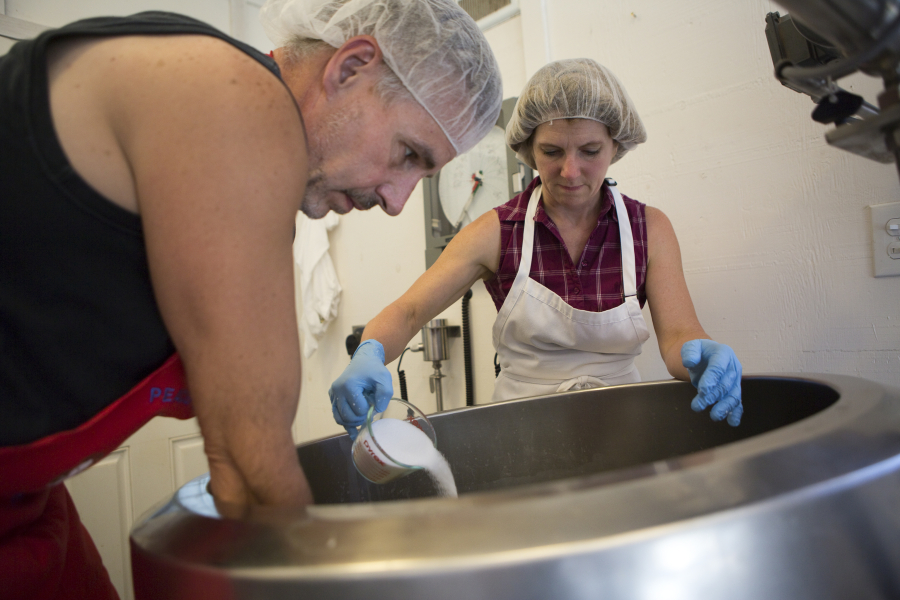CAMAS — When Lorrie Conway sets out a plate stacked with pieces of Yacolt Burn, she is serving up some well-aged heritage.
It’s not just that the orange-and-white morsels spent the previous year maturing in the Conways’ cheese cave.
Or that it’s named after the 1902 inferno that was a notable chapter in Clark County history.
You have to go back a lot further than that, back to the 1830s: That’s when Fort Vancouver became the cradle of the Pacific Northwest’s cheese industry, thanks to the Hudson’s Bay Company’s dairy herd.
Shaun and Lorrie Conway are following that dairy tradition on their five-acre farm north of Camas, turning milk from their two dozen Nubian goats into cheese.
“When we say we make goat cheese, most people think of the traditional soft chevre-style cheese,” Lorrie Conway said. The couple tried that, and — from a production standpoint — found it unsatisfying.
“But aged goat cheeses are also common,” she said. “Most any type of cheese can be made from most any type of milk — with some varying results.”
On a recent Saturday, the Conways produced about 50 pounds of Yacolt Burn at their creamery. The process started at about 5 a.m., when they poured 48 gallons of milk into a vat.
(One gallon of milk produces about a pound of cheese, Shaun Conway said.)
The milk is pasteurized — “We don’t sell raw milk or raw-milk cheese,” Lorrie Conway said — and the vat then becomes the cheese-making vessel. A starter culture changes the lactose, or milk sugar, into lactic acid.
A vegetable-based rennet is added to curdle the milk, creating clumps, or curds, that are separated from the remaining liquid. The liquid, called whey, is drained off.
They stir in about 1 1/2 cups of salt, and then add powdered paprika to give Yacolt Burn its light orange colby-jack style marbling.
Seven hours into the process — a little after noon — it’s time to reach into the vat and start breaking up the curds with their hands.
“It’s almost a waste of time: break it up, and then press it together” a few minutes later, Shaun Conway said.
Round molds, lined with cheesecloth, are filled with curds. Lorrie Conway gently presses out some of the liquid. By 1:30 p.m., they have nine full molds on the counter and are done for the day.
Making cheese is a Saturday activity because they both have full-time jobs. Shaun Conway works for a freight company in Portland; Lorrie Conway is administrator at St. Thomas Catholic Church in Camas.
There is some finishing work on Sundays. They take the cheese out of the molds to air dry for a few days, and then the wheels of cheese are sealed in plastic bags. They’re stored for at least a year in a cheese cave, which is a bunkerlike structure the Conways had built into a convenient hillside.
The couple make about 1,500 pounds of cheese during their six-month production season, which can stretch into November. Their cheese retails for $30 a pound.
Results may vary
The Conways are among 68 dairies listed on a map of Washington’s artisan cheesemakers. Another local producer is Cloud Nine Farm, near Ridgefield, operated by another husband-and-wife team. Pandora and Mark Milligan started making soft goat cheese in May 2016. Their cheese is being served in some restaurants, Pandora Milligan said, including Skamania Lodge.
While the Conways have their routines pretty well dialed in, batches can differ from week to week. The variables include the Conways’ individual touches.
“I think I’m not so precise as far as times go,” Shaun conway said. “I might work the curds harder. It’s artisan, so batches will be different.”
Getting to this point has been a 12-year process. Conways were licensed as a dairy in 2005 and sold milk.
“In 2009, we tried making soft cheeses. It bored me to death,” said Lorrie Conway, who was no stranger to livestock after growing up on a cattle ranch near Trout Lake.
They started experimenting with hard cheeses in 2010.
“We wasted two years on a culture we didn’t like,” Shaun Conway said. “We have thrown out a lot of cheese.”
But they learned something along the way.
“We always make things we like,” Lorrie Conway said. “If it doesn’t sell, we eat the failures.”
Did You Know?
•After Marcus and Narcissa Whitman and their missionary group arrived at Fort Vancouver in September 1836, she wrote enthusiastically about the food served by their Hudson’s Bay Company hosts: “There is such a variety I know not where to begin.” Well, she began with breakfast, and then worked her way through the extensive dinner menu and “last of all, cheese, bread or biscuit & butter.”




